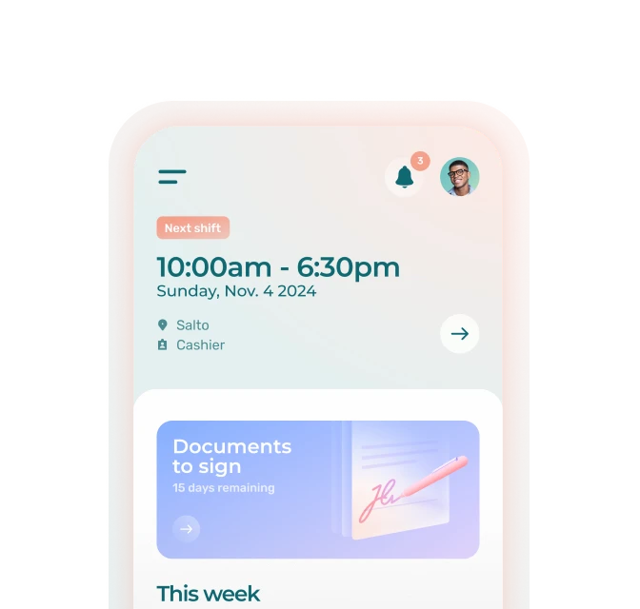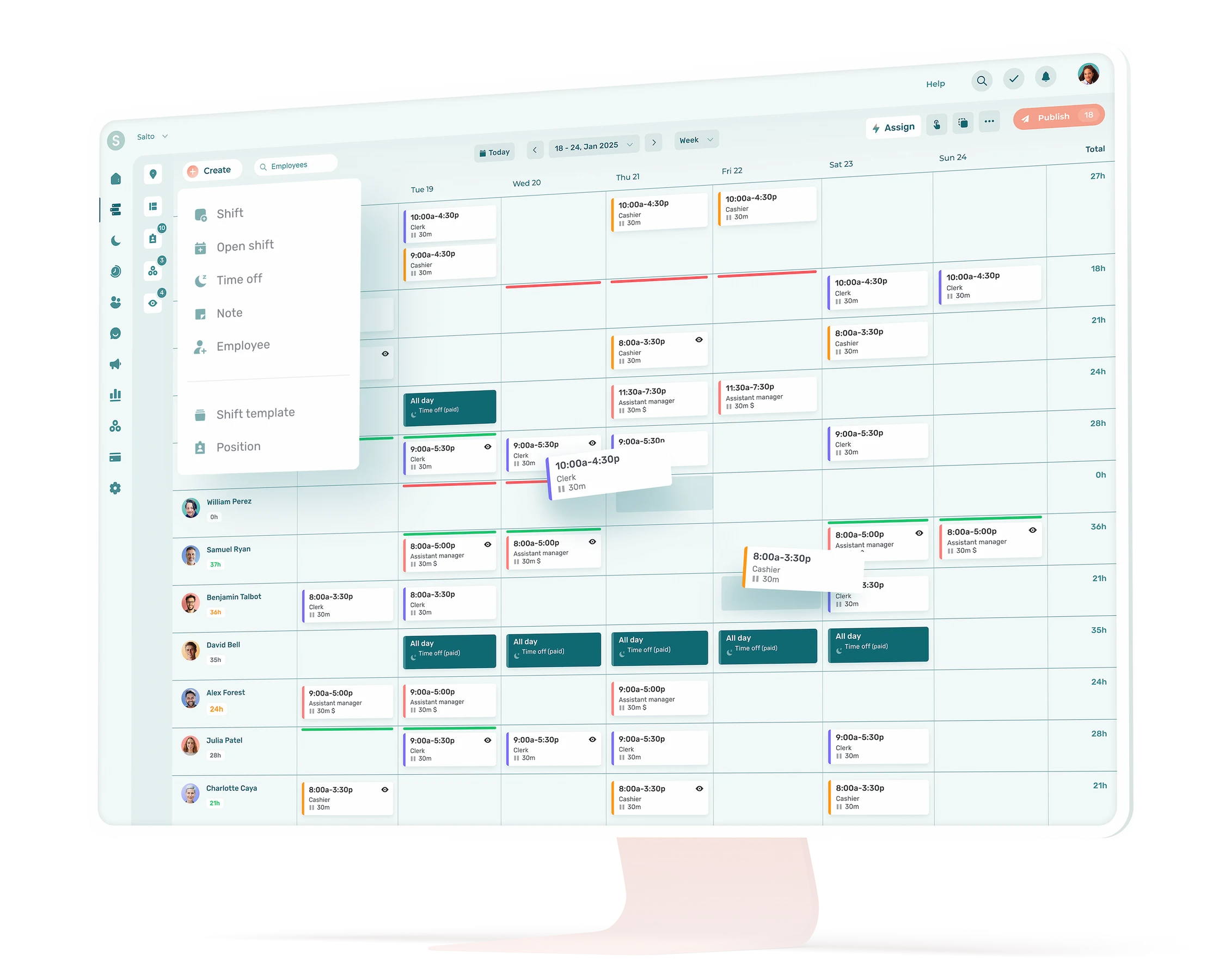Employee scheduling is a routine business task that—when done poorly—can lead to wasted time for managers, job dissatisfaction for employees and poor customer service.
Ironically, most employee scheduling problems can be easily solved with efficient employee scheduling methods and tools. Here are 11 of the most common scheduling issues managers run into, and how to fix them:
11 Most Common Employee Scheduling Problems:
- Poor organization
- Shortage of workers
- Overscheduling
- Employee no-shows & last-minute absences
- Employee turnover
- Vacations and time off
- Lack of availability
- Illness
- Overtime
- On-call scheduling
- Unequal shift distribution
11 Employee Scheduling Issues & How to Solve Them
Employee scheduling issues are one of the leading causes of job dissatisfaction and high employee turnover—for both managers and frontline workers alike.
Employee scheduling problems are commonly seen in industries like restaurant & bars, retirement homes, retails stores, and hotels & hospitality, which tend to be more vulnerable to high staff turnover and labor shortages.
1. Poor Organization
Disorganization is especially problematic when it comes to recurring tasks like employee scheduling. It has a direct impact on employee well-being and overall job satisfaction. By extension, it also affects customer service and business performance.
How to Tackle Scheduling Issues Caused by Poor Organization:
Take employee scheduling seriously. Recognize the direct impact employee scheduling has on job satisfaction, employee retention and business success. Allocate the time and resources needed to manage this recurring task in the most optimal manner possible.
Follow employee scheduling best practices. Whether you need to schedule part-time employees or full-time staff on a fixed or rotating schedule, there are proven techniques and approaches that will eliminate common employee scheduling issues.
Automate employee scheduling. This will eliminate the bulk of time-consuming manual work you need to do when creating, sharing and updating your work shift schedules. Reduce errors, share information in a timely manner and make last-minute scheduling changes much easier to manage.
2. Shortage of Workers
The current labor shortage is making it tough for businesses everywhere to keep enough employees on the payroll. Even the best business owner will have a hard time covering all shifts if there simply aren’t enough employees to fill all shifts.
Not all employees are open to working overtime hours. Other employees are more than happy to take on extra shifts. But too much overtime can lead to burnout, workplace accidents, and also result in poor customer service.
How to Tackle Scheduling Issues Caused by Shortage of Workers:
Hire more employees, especially part-time staff. Hiring more part-time employees to pick up the unwanted evening and weekend shifts frees your full-time staff. If your lack of workforce is due to low employee retention, however, this may only be a short-term fix. Pay special attention to new employee onboarding, implement fair scheduling practices, avoid last-minute changes, etc.
Make your business a more attractive place to work. Is the current labor shortage problem making it hard for you to attract job applications from potential employees? Are you unable to serve customers at an acceptable level? Consider sweetening the offer. For example, you can:
- Take employee shift preferences into account
- Give a flexible schedule
- Increase wages
- Offer better social benefits
- Contribute to transportation costs
- Offer more PTO for health-related reasons
- Provide free drinks and snacks
- Facilitate access to child care
- Allow employees to from home (when applicable)
Optimize your current workforce. Even as a small business, you can benefit greatly from using tools to optimize your current workforce. It will make it much easier to:
- Meet scheduling requirements
- Ensure each shift is covered by employees with the necessary skill sets
- Minimize paid overtime hours
- Take employee preferences into account
- Predict labor costs
Although work schedule templates can sometimes be useful, Agendrix Employee Scheduling Software makes creating online employee schedules and keeping track of hours worked easy. Accommodate shift swaps, requests for days off, and vacation time with ease.
3. Overscheduling
Overscheduling employees is a common scheduling problem that can lead directly to a high employee churn rate.
It can be sorely tempting for managers to overschedule their most trusted and dependable staff members. But scheduling an employee to cover the closing shift one night and have them come back in early the next morning for the opening shift can take a real toll on their employee satisfaction and job performance.
How to Tackle Scheduling Issues Caused by Overscheduling:
Aim to give team members at least 12 hours off between shifts. If that’s not possible, try to give them two consecutive days off to recuperate and maintain a healthy work-life harmony.
Keep track of all employee work and time off hours. Unlike with manual scheduling, time tracking software will notify you if you overschedule an employee so you can modify your schedule before finalizing and publishing it.
4. Employee No-Shows & Last-Minute Absences
Employees are only human. Sometimes things can suddenly pop up that make it impossible for them to show up for work—such as a medical emergency or a babysitter who calls in sick at the last minute.
According to the U.S. Bureau of Labor Statistics, on average, 3% of full-time salary workers are regularly absent from work.
Employee no-shows and last-minute absences are other scheduling issues that can leave an entire work shift in chaos, especially if the absent employee plays a critical role or possesses skills not easily replaced.
How to Tackle Scheduling Issues Caused by Employee No-Shows and Last-Minute Absences:
It’s reasonable for employers to expect team members to show up for their scheduled shifts or to provide advance warning if they are unable to do so.
Employers need to recognize that employees may miss shifts from time to time. Constantly changing or sudden shift changes can also increase the risk of employee absenteeism.
Set and communicate clear policies for employee absences to your team. These policies should cover both planned and unplanned absences. Avoid creating policies that may encourage no-call/no-show scenarios.
Be proactive and deal directly with the no-call no-show employee. Use your one-on-one meetings as a pretext to discuss the incident to find out what happened. Listen carefully and explain how no-call no-show affects business and team morale.
Plan on-call shifts. A good schedule should have at least one on-call employee for each shift. If an employee is unavailable to come into work at the last minute, there’s someone ready to cover at a moment’s notice, without the manager having to waste precious time.
Accommodate shift replacements and time off requests. Disregarding employee availability is a sure route to employees not showing up for their scheduled shifts. Shift swapping also helps reduce no-shows.
Make sure employees are fully aware of their shifts. Aim to create a consistent schedule for employees if possible. And if needed, require team members to accept their shifts.
Agendrix is an employee scheduling app that vastly simplifies the scheduling process for any business owner. It lets you see which employees have seen and accepted their work schedule.
Built-in timeclock systems can notify you if an employee hasn’t shown up for a scheduled shift. You can then either contact the employee to find out if they’re just running late, or inform on-call workers to come to replace them. See all the ways Agendrix simplifies employee management.
5. Employee Turnover
Quiet quitting may be the new workplace buzzword, but what really keeps the owners of small businesses up at night is employees actually quitting.
So far this year, more than 4 million people are quitting their jobs each month. A record-breaking trend with no signs of ending anytime soon. If that’s not scary enough, as many as 40% of workers are considering quitting their jobs soon.
Employee turnover can be devastating to a business. At an “acceptable” rate, it can negatively impact employee morale and team productivity. At the high rates we’re seeing today, it can make a serious dent in customer satisfaction and business reputation.
The COVID pandemic is not the only reason why so many employees are quitting. See other reasons why your employees are leaving you and how to reduce staff turnover.
How to Tackle Scheduling Issues Caused by High Employee Turnover:
Hire the right employees. Know what a good candidate looks like and improve your interviewing techniques so that you can properly vet potential employees. The right employee should not only fit the job requirements, but also make a good fit with the team and the company culture.
Improve your employee onboarding process. Research by Glassdoor has found that a good onboarding process can increase new hire retention by as much as 82%.
Take employee availability and work preferences into account. Whenever possible, accommodate the employee’s time off requests and preferences for working the day, night or weekend shift. An automated employee scheduling software like Agendrix will make it easy to juggle the entire team’s preferences.
Encourage a healthy work-life balance. Take employee preferences into account when creating employee schedules.
Support the employee’s professional development. Provide regular training and feedback on job performance. Help the employee set a career goal and help them work toward it.
Recognize and reward the hard work of employees. In addition to nurturing your employees’ well-being and motivation, it will improve employee loyalty and make your business a more attractive place to work.
See examples of employee appreciation messages.
6. Vacations and Time Off
Employee vacations and planned time-off may not create the same level of chaos in the workplace as an employee no-call no-show, but they certainly can make shift planning more complicated. Especially if you are still creating work schedules manually.
How to Tackle Scheduling Issues Caused by Employee Vacation and Time Off:
Cross-train employees. Instead of having to hire, onboard and train new talent, you can help your current team members to develop new skills all while covering your staffing needs at the same time.
Automate your scheduling process. An employee scheduling app like Agendrix will automatically notify you if you try to schedule an employee during their requested time off. That way, you don’t have to worry about inadvertently creating an emergency situation.
Using an integrated vacation tracking tool also provides a clear, shared view of upcoming time off, making it easier to manage planned absences and avoid scheduling conflicts.
7. Lack of Availability
You may want your retail or security business to operate 24/7, but your employees don’t. They want to work to live, not the other way around.
Many people prefer working the first shift, but some prefer to work the last shift or even work weekend shifts. As a manager, accommodating everyone’s scheduling preferences is a challenge. But if you insist on scheduling employees for shifts they don’t want to work, chances are they will simply say they are not available for upcoming shifts.
How to Tackle Scheduling Issues Caused by Lack of Employee Availability:
Improve your hiring practices. Hire a well-balanced crew of team members who are open to working different shifts, who have different skill sets, and who have different lifestyles and career ambitions. If most of your team is full-time staff with children, consider hiring some part-timers such as college students or semi-retirees so that harder-to-fill shifts like weekends and holidays are easier to cover.
Incentivize employees. Encourage team members to pick up more hours by offering bonuses, a higher pay rate or by better accommodating their scheduling preference.
Improve your workplace environment. Look for ways to make your business a more attractive place to work.
Become a better manager. According to a recent Gallup survey, 70% of employee engagement depends on the manager. Poor workforce management is a sure route to low employee availability.
8. Illness
Most managers would agree that stopping presenteeism—the phenomenon of employees coming into work when sick, injured or because of another condition—is important. Managers need to factor the likelihood of employee absence due to illness into work schedules.
How to Tackle Scheduling Issues Caused by Employee Illness:
Reexamine your workplace. If employees are frequently falling ill, it might be a good idea to ensure you are providing a safe and healthy workplace. And that your work schedules allow for a healthy balance between work and life. When workers are balanced and happy, they are more productive, take fewer sick days, and are more likely to stay in their jobs.
Schedule a back-up employee. Schedule at least one on-call employee for each shift if an employee is unavailable to come into work due to illness.
Add more flexibility to work schedules. If an employee is not up to working an entire shift, but is otherwise physically and mentally able to work a shorter shift, consider allowing this option. Or let them work from home, if their role allows.
9. Overtime
Employee overtime is sometimes necessary, but eventually it will increase labor costs and can potentially lower employee morale.
Scheduling excessive overtime hours can also increase the risk of burnout. It can negatively impact customer service, further cutting into your business profits.
How to Tackle Scheduling Issues Caused by Overtime:
Avoid scheduling overtime hours. Set the maximum work hours an employee can work. Use employee scheduling software that automatically flags you if you schedule an employee too many work hours in one week.
Monitor work hours carefully. Scheduled work hours and actual work hours aren’t necessarily the same thing. Use automatic time clock/time tracking software so that you can see in real time how many hours each employee is racking up as the week advances.
Hire more employees. If despite your best efforts you’re not able to avoid overtime work for your existing team, consider adding new team members.
Curb your business hours. This is a drastic measure, but one that may be necessary if labor costs, worker fatigue or customer experience are excessively impacted.
10. On-Call Scheduling
Scheduling employees on-call has long been standard practice in industries with unpredictable customer demand or rush times such as call centers, restaurants and retail stores.
Having employees on stand-by can be a lifesaver for your business, but it’s also frustrating for your employees, as this scheduling practice makes it difficult for them to plan their day.
Team members may be called at the last minute, telling them to come into work. They can just as easily be called to say “It’s quiet; stay home.” This can create undue stress, low employee satisfaction and poor job performance for your staff.
How to Tackle Scheduling Issues Caused by On-Call Scheduling:
Study past staffing and customer traffic trends. Job scheduling software will let you see your historical data with just a click, making it easier to determine the right number of staff for each shift.
Offer better benefits to on-call staff. Compensate workers for the extra aggravation of having to be on-standby.
Guarantee a minimum number of hours employees get called in. Even if they don’t end up working all these hours. It can drastically lower your employee turnover rate.
Use extended shifts. This alternative approach to on-call scheduling notifies employees while they are at work if they are needed to stay on the job a little longer. Rather than organizing their day around the possibility that they may or may not be called in, employees simply work a few more hours that day.
Give employees more control over their work schedules. Use employee scheduling software to let employees state their work availability, specify their shift preferences, and swap shifts autonomously. It will significantly reduce headaches for management and boost employee satisfaction.
11. Unequal Shift Distribution
Different workers have different shift availability, but also job skills and strengths. All managers have a certain team member who they prefer for specific tasks, such as store opening or closing.
As a manager, it’s important to be business-smart, but also employee-fair. Unfair scheduling will affect your team’s morale.
How to Tackle Scheduling Issues Caused by Unequal Shift Distribution:
Use scheduling software. It will let you see the distribution of employees at a glance.
Accommodate shift preferences. Create schedules that let employees work their preferred shifts, while also taking into account experience. This will boost employee loyalty and boost profits for your business.
Solve Even the Most Challenging Scheduling Problems With Agendrix
Business managers and SMB owners constantly face all sorts of employee scheduling issues. Those who adopt Agendrix scheduling software see many of these problems disappear almost overnight.
Automating employee scheduling will make better use of your human resources, lower labor costs, and improve your customer experience.
Join the many businesses that improved business results with Agendrix software.
What Is the Most Challenging Part of Scheduling?
For many SMB owners and managers, the biggest challenge in employee scheduling is managing staffing from a business profitability perspective.
A good schedule ensures enough staff of the right skill sets cover each shift.
The best schedule also minimizes costs and maximizes team productivity, employee morale, and customer service—all while saving business owners precious time.
Improving these key performance indicators can be achieved with employee scheduling software.
What Are the 4 Types of Work Schedules?
1. Full-time – Traditionally a work schedule of 40 or more hours per week, although 30 or 35 hours a week may be considered full-time hours, depending on the business. Full-time jobs typically offer perks and benefits such as health insurance and retirement plans.
Full-time work schedules are commonly found in offices & call centers, cities & municipalities, pharmacy, and healthcare.
2. Part-time – Typically a work schedule of 34 hours a week or less, and may involve working any hours, day or night. Part-time work tends to have more flexible hours, but fewer benefits than a full-time work schedule.
Part-time work schedules are often found in retail, restaurants & bars, and catering.
3. Flexible – Flexible schedules can be part-time or full-time; but employees are generally free to pick and choose their own work hours. Flexible jobs are increasingly popular among workers looking for a better work-life balance as they allow people to work around family responsibilities and other interests.
4. Alternative – Generally, work hours outside the normal Monday to Friday, 9 am to 5 pm job. Second shifts (evenings), third shifts (night shifts), and weekend shifts all fall under an alternative work schedule.
Alternative schedule jobs are well suited to people who are unable to work during normal business hours because they are at school, working another day-time job, or need to be at home as a caregiver.
Alternative job schedules can be found in restaurants & bars, events & recreation, seasonal & tourism, and security services.










